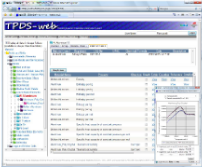

- TPDS-web operation manual -Update:2009/04/15
OutlineTPDS-web/full is the software to browse Network Database System for Thermophysical Property Data via web browser. Therefore, these data structures are the same. In our database, material data and property data are maneged separately and it is characterized by material classification using hierarchical structure and data reliability classification for property data. By understanding these characteristics, you can utilize TPDS-web/full more effectively. This section describes it in detail.1.1 Material classification and hierarchical structure In our database, materials fall into 8 classifications according to chemical property or phase state and are organized systematically using hierarchical structure. In the case of solid which is most diverse, classification example is as Table 1. The folder colors in the table corresponds to those in TPDS-web/full. |
|||||||||||||||||||||||||||||||||||||||||||||||||||||||||||
| Table 1 Material classification standards and hierarchical structure | |
1st stratum |
Classification by perspective of the community of study or technology (also by phase state at ordinary temperatures and pressures) |
2nd stratum |
Material classification Example: Metal, Ceramics, Semiconductor |
3rd stratum |
Material group 1 Example: Oxide, Carbide (in case of ceramics), Transition metal, p-block metal, Alkali metal (in case of metal) |
4th stratum |
Compound name |
5th stratum |
Material name 1 |
6th stratum |
Material name 2 |
7th stratum |
Lot name |
8th stratum |
Sample name |
Category |
Meaning |
Measured |
Measured value |
Derived |
The data derived from physical law based on measured value |
Synthesized |
The data derived from comparing, synthesizing and fitting previous data with instrument data (on the same thermophysical property) |
Simulated |
The data derived from numeric calculation such as first principle molecular dynamics |
Theoretical |
The theoretically-derived property data |
Others |
Others |
Category |
Meaning |
International Standard |
International standard value |
National Standard |
National standard value |
Traceable Measurement |
The value derived from traceable measurement to national standards such as using the measurement system is proofread based on authentication standard materials |
Industrial Standard |
The measured value in line with industry standard (such as ISO, JIS) |
Unknown |
others |
Category |
Meaning |
Reviewed Journal |
The data in manuscripts reviewed by referees or editional committees of academic journals |
Recommended |
The data recommended by society, public institutions, company or scientists for data evaluation |
Certified |
The value authenticated by the traceability to national standards |
Catalogue |
The data evaluated by material suppliers under their responsibility |
Others |
The authenticated data on the grounds other than listed above |
Unknown |
Unrecognized data or the data is not clear whether it is authenticated or not |
